After leaving the relatively small cities of Pushkar and Udaipur, we were heading to the much larger cities of Jaipur and Agra. By this time, as you probably gathered from reading Sarah’s blog, we have started to enjoy India a bit more. We will never really enjoy the insane crowdedness, the pollution, or the constant lies that tourists face from people looking to make a quick buck (win-win is not a concept that we have encountered here), but India has some neat attractions, the actual ordinary people are really quite nice, and the food is really good. Plus, everyone was talking up Jaipur, and we were really looking forward to the Taj Mahal!
Our drive from Udaipur to Jaipur was long and not as scenic as the really nice country drive that we had enjoyed on the way to Udaipur, but Surender (our driver) played some lively, fun Indian music to help pass the time. We also stopped at one of the best restaurants we’ve been to in India; it was also the first place where we have been the only white people–if there had been a jukebox in the place, it would have stopped the moment my toe touched the floor, but stares soon turned to smiles, and it ended up being very good food at truly local prices.
After finding a hotel that evening, we walked to a sort of boardwalk on the local lake and had a look at the floating Water Palace. While it is not much to look at during the day (it is actually closed for restoration), they light it up at night. The romantic, soft glow also reflects onto the water around it, and it makes for a nice nighttime view of the lake.
Jaipur is huge–one of the 25 fastest growing cities in the world, and the traffic is terrible. Some of the areas are really upscale, most of it seems very poor, and a third area–the part with most of the attractions–is known as the pink city, named for the color all of the buildings were coated in as part of an attempt to camouflage the poor quality of building materials.
Our first destination was actually outside of town, however, in the nearby Amber Village. The Amber Fort is a large old city up on a hill outside of Jaipur. The most impressive things about it are the excellent views of the surrounding hills from the upper levels of the fort, and the intimidating fortress wall–which extends far beyond the remaining buildings of the fort itself. After entering the main gate and dodging some of the most annoyingly persistant hawkers that we have encountered, we passed through the Ganesh Pol (a “pol” is a gate, and Ganesh is a Hindu god with an elephant head on a human body), which is painted brightly with all kinds of intricate designs.
Once inside, we toured through a series of courtyards (one with a beautiful fountain), a marble building lined with colored glass and mirrors called the Sheesh Mahal, and the Palace of Man Singh I–which would have been the original part of the fort built in 1037. Like many of the other attractions we’ve seen in India, the ancient fort is badly weathered and mostly unrestored, but the good parts were really good, and we enjoyed roaming around the upper corridors and taking in the views.
Back in Jaipur, we later entered the Pink City. Among the landmarks here are the City Palace, the Hawa Mahal, and the Jantar Mantar–you are probably wondering what the heck those last two are, as was I, but if you would just trust me a little for once, you will find that I will tell you. :) We decided to skip the City Palace, partly because it was pretty expensive, but mostly because we were already sort of “palaced out” from Udaipur, with one more to go in Agra.
Instead, we headed for one of the most unique things that we have seen on the entire trip–the Jantar Mantar–but not before taking tea in the parking lot with Surender and his friend, who promptly offered to clean my ears for me (he claimed to be quite good at it, but I had to respectfully decline). Anyway, the Jantar Mantar was actually something that exceeded our expectations. Apparently, the Emperor Jain Singh was an astrology nut, and he had a bunch of different astronomical measuring devices built here in the 1700’s; he even designed a bunch of them himself. Sarah understood them better than I did, and she helped explain how they worked to me. Basically, most of them were in some way aligned with North and South, with some sort of incremental scale attached to the column or bowl-shaped device, and shadows were used to measure information such as time or the altitude of the stars/planets. One sun dial, the world’s largest, rose 27 meters above the ground and is accurate to within 2 seconds! Others were built according to the zodiac and would only be accurate during that time of the year; these were often used to help make decisions about which dates would be lucky for events such as marriage. Come to think of it, I should have checked with someone about April 9, but I guess I’ve been pretty lucky so far (Sarah is watching over my shoulder as I type this, so it behooves me to write that last sentence…ouch, stop hitting me! Anyway…).
From there, we moved on to the Hawa Mahal, or Ladies’ Palace, which is best enjoyed from outside the city walls, meaning that we had to risk crossing a street that would make even the most skilled Frogger expert…even George Costanza–cringe in fright. This bright pink facade with it’s multiple screen-covered balconies, is one of the defining faces of the Pink City, however, and it was really quite a sight. It was built in order to allow ladies of the court to observe parades and stuff without being seen in proper society. It is not actually worth going into, being small and unremarkable on the interrior, but the outside view is good. We actually got an even better view by taking up a salesman’s offer to go up to his “private residence” above street level, where we promptly took a picture and dashed back down the stairs as he pulled out the 10,042nd carved elephant figurine that we have been offered in the past week. I guess if you can’t escape the madness, you might as well work it a little.
Our plan that night was to go to a Bollywood show at the well-known Raj Mandir Cinema, which is famous for its fancy lobby and 1,500 seat theater. Unfortunately, the equivalent of a summer or Christmas blockbuster was opening that night, and tickets were sold out by the time we joined the line. Several kids (none of whom had tickets, since they were actually in line with us) offered to get us tickets, but we once again had to respectfully decline (although I did think about offering to clean their ears for them).
Although only a bit disappointed in missing out on the movie experience, we did have a minor problem now. Surender had dropped us off and gone to see his nephew, and his phone was not working when we tried to call him, so we were on our own without a map for three hours. So while searching for a restaurant, Sarah and I stumbled onto (better than stumbling into) our first Indian bar. For the second time in India, we were the only white folks, not to mention Sarah was the only woman. We agreed to head out at the first sign of trouble as the imaginary jukebox stopped again (Doug, I was bigger than everyone there and a pretty good shot with a bottle to boot :)…), but aside from a few more stares, we enjoyed a beer in peace. Beer is relatively expensive, and of course we got tourist prices, but it was a fun treat on a weekend night and the end of our time in Jaipur.
Monday morning, we visited the Monkey Palace on the way out of Jaipur. A series of 250 year old temples are built into the hills here, but the reason we were interested was the fact that over 5,000 macaque monkeys live in this area. We weren’t disappointed; there were monkeys everywhere, along with a ton of people visiting one of the lower temples and bathing (a religious rite) in the pond beside it. We hiked up to the highest temple, accompanied by several friendly and very giggily Hindu women, where we enjoyed some awesome views of Jaipur, which is even larger than we had imagined. On the way down, a cow tried to gore me, which according to my best theory, was karma biting me in the butt for all the steak I ate in South Africa…either that, or it was really the reincarnated soul of my childhood snauzer, Sophie May, who loved chasing cows, winking slyly, as if to say, “Yo, Mikey, I still got it!”
The drive to Agra was another long and boring one; maybe things would be easier if we weren’t spending every other day in the car, but it is the best we can do with all of the night trains full. Although we were really tired when we got to Agra, we were both excited to see the Taj Mahal the next day. It was Halloween that night, so we found some Oreos (the best we could do) to share in celebration before going to bed early–actually, I am telling lies; we stayed up late because our hotel’s TV actually worked, and they had HBO–so that we could wake up in time for sunrise at the Taj.
Some monuments need to grow on you, and some you don’t even appreciate until after you’ve left them and had time to reflect on what you saw. The Taj Mahal is not one of those monuments…one glance knocks you off of your slipper-covered feet. The symmetry, the curves, and soft pink glow from the rising sun all contribute to the building’s exuding perfection. It is not an attraction that you sprint towards; instead, you approach slowly, stopping to admire it from a slightly different vantage points every few feet, soaking up the perfect marble lines and curves.
Built starting in 1632 and finished 21 years later, the Taj Mahal was a shrine to house the remains of Shah Jahan’s favorite wife, who died in childbirth. It required the work of over 20,000 people. When the Shah’s son eventually overthrew him, it is said that the fallen ruler spent the rest of his days staring wistfully at the Taj Mahal from his place of imprisoned exile in the Agra Fort across the river. Upon his death, he was buried in the Taj in a tomb–the only part of the whole place that is out of symmetry–beside his wife.
Inside, the marble is exquisitely carved and inlaid with floral patterns filled with semi-precious stones, such as jade and onyx. In fact, no small area was left devoid of detailed attention–the entire building is a work of art. The ornate tombs sit in the center, the wife’s tomb sitting in perhaps the most perfect homage ever made by a husband; Sarah asked if I was going to do that for her someday, but I artfully sidestepped the question…oh look, honey, isn’t that the fake mosque that was only built for the purpose of maintaining symmetry…yes, I do think you can go into it…using the wit for which I have become known around the world. We spent a good three hours taking in the beautiful building, and it was far and away the best thing we have seen in India, and right at the top for the entire trip.
The Taj Mahal would be nearly impossible to beat, but we did do a little more sightseeing that afternoon, beginning across the river at the Agra Fort. It dates back to sometime in the 11th century, but most of it was rebuilt in the mid-1500’s. Once a large, developed compound, only around 20 structures remain within the standard red sandstone walls that we have come to know and, well, know. Among the highlights of the Agra Fort were the Gem Mosque–an elegant place delicately shaped from marble that was built as a place for women of the Harem to pray–a beautiful “grape garden” that was actually a well-manicured grass and flower garden with exotic pink flowers blooming everywhere, and a large marble pavillion that was probably the private palace of the Shah.
Our final attraction for the day was the “Baby Taj,” a separate shrine that actually predates the Taj Mahal itself. It is much smaller and far less symmetrical than the Taj Majal, but it is still a pretty neat building. Also made of marble and inlaid with bright but less valuable stones, we enjoyed a short stop here…plus we got to wear some awesome shoe covers while we checked things out.
Before we could get back to the hotel and say goodbye to Surender–we were on our own after today–we had to endure an awful traffic jam, and even worse, we were stuck on a bridge. As we sat there, surrounded on all sides by cars, rickshaws, motorcycles, bicycles, pedestrians, a horse-drawn wagon (the horse rearended us twice), and a large tractor, it occurred to me that the bridge is a death trap–easily doubling the weight allowance on a daily basis and probably woefully undermaintained. It’s impossible to actally hold one’s breath for the 45 minutes we spent making our way across, yet somehow I think that I came close.
We were really nervous about tipping Surender, as no real guidelines were given anywhere that we had read, and he had made it pretty clear that he thought we were rich throughout our experience with him. We both liked him and wanted things to end well. Fortunately, things did go well, and he seemed quite please with the amount that we gave him, and we all parted ways in satisfaction.
That night, we boarded our first night train–destination Kuajaraho, known for some very unique temples–tired but glad to be back on our own. Delhi had sort of chewed us up and spit us out when we got here, so it was time to prove to ourselves that we could handle India just fine.




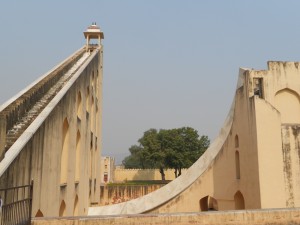
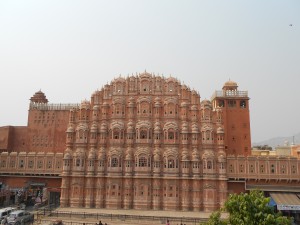

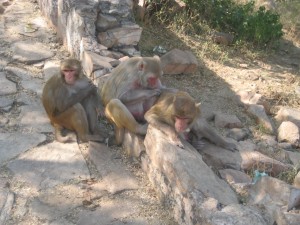

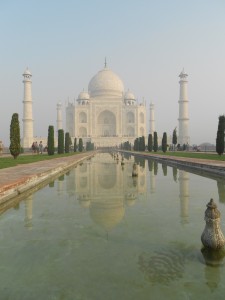



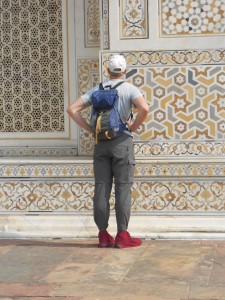


Love the George Costanza reference. 🙂
Glad you’re having some fun in India! The Taj Mahal looks amazing!
Thanks, Leslie. Hope school is going well!